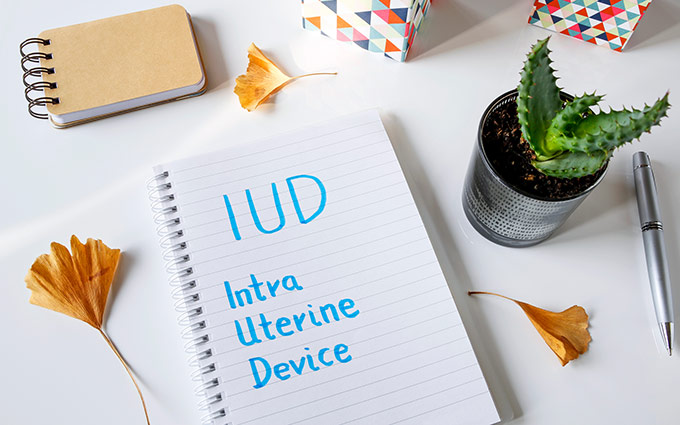Intrauterine devices (IUDs) are small contraceptive devices that are put into the uterus (womb) to prevent pregnancy. The copper IUD and the hormonal IUD (Mirena and Kyleena) are the two types currently available. Both are very effective methods of contraception and can stay in place for 5 to 10 years.
IUDs, both copper and hormonal, do not give protection from sexually transmissible infections (STIs). The best way to lessen the risk of STIs is to use barrier methods such as condoms with all sexual partners.

The IUD is for you if you want the most effective method to prevent a pregnancy, want to delay a pregnancy for at least 1-2 years, and would like to avoid estrogen products (women with clotting disorders, high blood pressure, migraines with aura).
Advantages of a IUD over other birth control methods:
- Easy to use – you do not have to remember to insert it before sex or to take a pill every day.
- Does not interfere with sexual intercourse or daily activities. Vigorous physical activity, such as jogging, or dancing will not dislodge it.
- Once it is in place, you cannot feel it, and neither can your partner.
- It is a highly effective method of contraception (99.8% effective)
- it is cheaper than other contraception (more expensive at first but cheaper over the long term)
- Return of fertility almost immediate after removing IUD
The IUD may not be the ideal method of birth control for women who have:
- Multiple sexual partners or are at high risk for sexually transmitted diseases (STDs)
- Very painful or abnormally heavy periods (for Copper IUD)

Choosing the IUD
The copper IUD may be a good choice for you if:
- Your menstrual cycles are light or normal
- You have problems with hormonal methods of contraception
- You have had failure with other methods (cannot remember to take the pill)
- You are breastfeeding (it has no effect on breast milk)
The Mirena or Kyleena may be a good choice for you if:
- Your periods are on the heavy side, or you want to avoid or skip your periods
- Mirena decreases menstrual cramping and dramatically decreases menstrual blood loss (~80% reduction).
- Mirena can reduce the pain of endometriosis.
- Kyleena is smaller in size and suitable for young women who have never been pregnant, also reduces menstrual bleeding by 50%
- You are breastfeeding (it has no effect on breast milk)
- You have completed your family but do not want a tubal ligation
There may be irregular bleeding up to 6 months, and then periods usually get lighter than normal. Some periods disappear completely.
The Procedure
The IUD is inserted during a simple clinic procedure (the actual procedure is only a few minutes). The doctor will examine you and then insert a speculum (like the one used for pap smear/cervical screening test).
The cervix is held in position and the uterus is measured for length, and the IUD is then placed inside the uterus.

Most women feel cramping during the process of measuring, as well as when the IUD is placed. It is normal for the cramping to last a few minutes, and some will experience cramps for up to a week.
Occasionally some women feel faint or lightheaded after the procedure. This settles by itself in 10-15 minutes.
Communication and realistic expectations are the key to a better IUD experience.
Risks of IUD Insertion:
- Uterine perforation: 1 per 1000 insertions (rare). All perforations occur or are initiated at the time of IUD insertion.
- Infection: 1-2 in 1000 risk for pelvic infection exists in the first 2 weeks following the insertion but the risk is the same as a non-IUD user thereafter.
- Expulsion: 3 – 5% risk of IUD expulsion (falling out) leading to risk of pregnancy, usually in 1st year. A user who has previously expelled an IUD has a 30% chance of expelling a subsequent IUD.
- Failure: If a woman becomes pregnant with an IUD in place, the presence of an ectopic pregnancy must be excluded. If the woman chooses to continue the pregnancy, the risk of miscarriage is increased as long as the IUD remains in place.
Preparation for IUD insertion
Please take the time to carefully read the following information and advice regarding the insertion of IUD (Mirena/Copper). This will ensure that insertion of your IUD can proceed with the best chance of success and comfort for you.
The IUD insertion can be done anytime if there is no chance of a pregnancy, or at the end of your period.
IUDs need to be purchased from a pharmacy with your prescription prior to your insertion appointment.
Please take a form of simple pain relief (PARACETAMOL and /or IBUPROFEN) about 1 hour prior to your appointment for insertion of IUD and have some at home if further doses are required later.
- Please ensure that you have had a normal amount to eat and drink prior to your appointment.
- In some cases, it is NOT POSSIBLE to safely insert an IUD despite best planning and efforts and the procedure will need to be abandoned.
- Arrange for someone to pick you up if possible
- Plan to have a quiet day following insertion of an IUD
- A medical certificate can be provided if necessary.
When to Call the office:
- Missed, late, or unusually light period using the Copper IUD
- Severe cramps, pain, or tenderness in your abdomen
- Pain or bleeding during sex
- Unexplained fever or chills
- Unusual discharge from the vagina or sores on your genitals
- If the pain or bleeding is intense and you think that you are pregnant, or if you have pain and a high fever, you need to go to your nearest Emergency Department.
To book your appointment for IUD insertion or removal, please contact us on (03) 9873 6767 or email us via our contact form.



